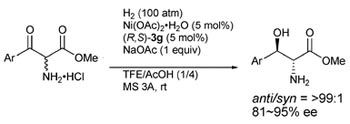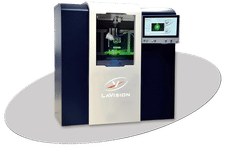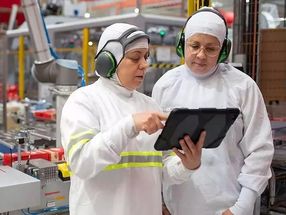Organic molecules spontaneously organize themselves into large spherical structures
Advertisement
A critical step in the emergence of life was the spontaneous self-organization of identical small units into large symmetrical structures. The outer shells of viruses and many other such subunits are assembled by this mechanism. In this manner, a minimum of information, a single gene that provides the assembly instructions for a specific protein, results in maximum structural complexity - the above-mentioned spherical virus shell, which consists of 60 or more individual identical protein building blocks.
M. Fujita and his co-workers used this natural construction method as a model when developing their self-organizing spherical networks of organic molecules. From previous research, they knew that short, rod-shaped molecules whose ends can interact with metals form two-dimensional grids. These networks have no set boundaries, and can theoretically grow infinitely large. For their experiments, the researchers thus used slightly bent molecules and treated them with a solution containing the precious metal palladium. This resulted in the spontaneous formation of large, spherical structures with diameters of about 4 nm. In a variety of different measurement processes, each sphere acted as a single large molecule; it was even possible to crystallize them. It was thus possible to determine their exact composition; each contains 12 metal centers and 24 organic units.
Imaginative chemists can now alter the surface of the spheres in a variety of ways, because functional groups that can be linked to organic ligands are spread evenly over the surface of each sphere. For example, the Japanese researchers coupled porphyrin systems to the ligands. Porphyrins consist of four linked, nitrogen-containing rings arranged around a metal center. In nature, porphyrins are found in light-absorbing proteins or in the green substance in leaves, chlorophyll. They absorb light energy from the sun, making it available for biochemical syntheses within plant cells. In hemoglobin, the red substance in vertebrate blood, a porphyrin system is responsible for the transport and exchange of oxygen and carbon dioxide. It may someday be possible to use Fujita's method for the production of tiny gas or light sensors.
Other news from the department science
These products might interest you
Most read news
More news from our other portals
See the theme worlds for related content
Topic world Sensor technology
Sensor technology has revolutionized the chemical industry by providing accurate, timely and reliable data across a wide range of processes. From monitoring critical parameters in production lines to early detection of potential malfunctions or hazards, sensors are the silent sentinels that ensure quality, efficiency and safety.

Topic world Sensor technology
Sensor technology has revolutionized the chemical industry by providing accurate, timely and reliable data across a wide range of processes. From monitoring critical parameters in production lines to early detection of potential malfunctions or hazards, sensors are the silent sentinels that ensure quality, efficiency and safety.



































































